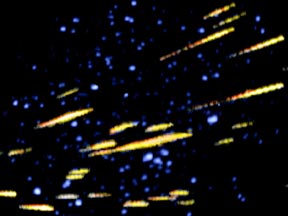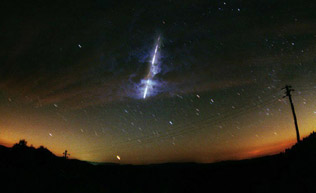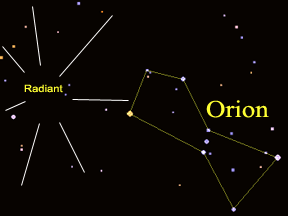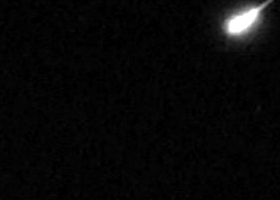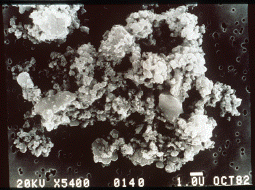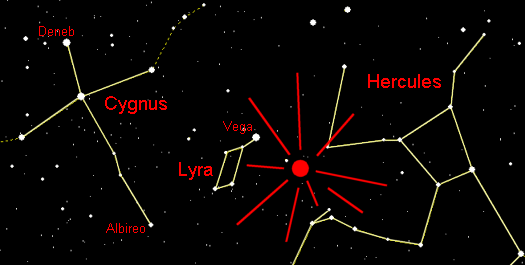Click on image for full size
Image courtesy S. Molau and P. Jenniskens, NASA Ames Research Center.
Related links:
Meteor Showers
A meteor shower is an astronomical event during which many meteors can be seen in a short period of time. Most meteor showers have a peak activity period that lasts between several hours and a couple of days. During this peak period, observers may spot between about 10 to more than 100 meteors per hour in the case of the major meteor showers. On rare occasions, during an extraordinarily intense meteor shower, observers might see as many as thousands of meteors per hour. There are about eight major meteor showers each year, and many more minor showers that produce smaller numbers of meteors.
The meteors from each meteor shower seem to fan outward from a specific spot in the sky. This spot in the sky is called the shower's "radiant". The name of each shower is derived from the location of its radiant. For example, the radiant of the Orionid meteor shower is in the constellation Orion, while the radiant of the Geminid meteor shower is in the constellation Gemini.
Astronomers have long known that each meteor shower occurs around the same date each year, year after year. Why is this so? The many small meteoroid particles that produce meteor showers are actually the cast-off debris from comets! As comets occasionally swing close to the Sun in certain parts of their orbits, the icy materials that make up the bulk of the comets are heated and melted. They escape into space, trailing behind the comets as the spectacular tails that we sometimes see from Earth. Although comets are mostly made of ice, they also contain bits of dust and small rocks embedded within the ice. As the ice melts, the rocks and dust also are freed and float off into space. Gradually, this cloud of debris drifts away from the comet itself, but continues to orbit the Sun along roughly the same path as the comet. Over many years, the debris spreads out along the orbit of the comet. When Earth, traveling along its orbit, crosses a comet's orbit (though not necessarily anywhere near the comet itself), the cloud of debris slams into our atmosphere at high speeds, producing a meteor shower! For example, the Orionid meteor shower, which happens each October, is generated by Earth's passage through the debris stream strewn along the orbit of the most famous comet of all - Halley's Comet!
Most meteoroid particles that generate the meteors in a shower are quite small, ranging in size from a grain of sand to a pea-sized pebble. However, the particles are traveling extremely fast relative to Earth when they streak into our atmosphere. Typical speeds range between about 20 and 70 km per second (45 thousand to 157 thousand miles per hour)! The incredible pressure meteoroids experience when they collide with Earth's atmosphere shatters them, transferring energy to atoms and molecules in the atmosphere, which then release the energy by glowing. This glow produces the bright trails of light in the sky we see as meteors.
Although the peak activity period for each meteor shower lasts a short time, it is often possible to see at least a few meteors associated with a given shower for several days before and after the peak. How should you look for meteors when there is a shower? Find a comfortable place to sit or lie down outside; lounge chairs that let you recline for viewing the sky are ideal. You don't need to look directly at a shower's radiant to see meteors; though the meteors will seem to fan out from the radiant, they will be visible all over the sky. It is best to be sure that the constellation in which the shower's radiant lies is in the sky; take a look at our sky maps to help you with this. Since many meteors are faint, it is best to get away from lights if you want to see many meteors. Some years a shower's peak happens near the time of a full moon; those are not the best years to view that shower. The best time for viewing meteors is between midnight and dawn, but meteors can be seen at any time of night if you don't want to stay up that late!
Here is a list of the major meteor showers that can be seen each year:
- Quadrantids (early January)
- Lyrids (mid to late April)
- Eta Aquarids (early May)
- Delta Aquarids (late July)
- Perseids (mid August)
- Orionids (mid to late October)
- Leonids (mid November)
- Geminids (mid December)


